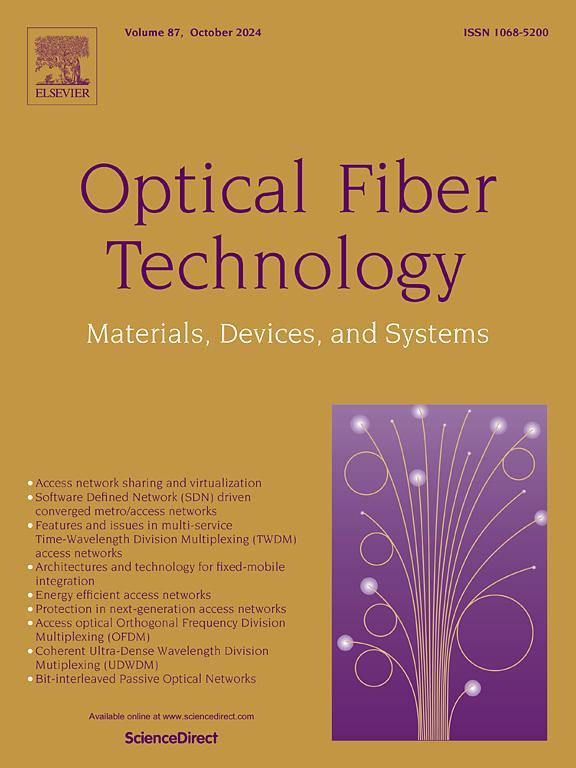Harmonic Vernier effect-enabled optical fiber biosensor for ultra-sensitive detection of CA125
IF 2.7
3区 计算机科学
Q2 ENGINEERING, ELECTRICAL & ELECTRONIC
引用次数: 0
Abstract
A highly economical fiber immunosensor with the harmonic Vernier effect (HVE) is reported for cancer antigen 125 (CA125) tumor marker detection. The sensor architecture is constructed using a special fiber fusion splicer to cascade three sections of single-mode fiber (SMF) in sequence with a large offset. This configuration yields a cascaded Fabry-Perot interferometer (FPI) architecture incorporating the HVE. The misalignment fusion design facilitates direct and seamless interaction between biochemical fluids and optical signals. Experimental results demonstrate that the refractive index sensitivities of the internal envelope and upper envelope reach −5236, and 1163 nm/RIU, respectively, when refractive index increases from 1.334 to 1.339. It has excellent consistency with the simulation results of −5375 nm/RIU and 1257 nm/RIU as refractive index increases from 1.334 to 1.335. Obviously, the refractive index sensitivity is significantly enhanced via the HVE. The designed sensor is further biologically modified with the 50 μg/mL ovarian cancer 125 monoclonal antibody, enabling varying cancer antigen 125 concentrations detection. The proposed biosensor has low detection limit with value of 44.12 fg/mL and a fast response time (<30 min). Therefore, the proposed biosensor has latent application as an ideal platform for disease diagnosis and medical detection.
谐波游标效应光纤生物传感器超灵敏检测CA125
报道了一种具有谐波游标效应(HVE)的高经济纤维免疫传感器,用于检测癌抗原125 (CA125)肿瘤标志物。该传感器结构采用一种特殊的光纤熔接器,将三段单模光纤(SMF)按大偏移量顺序级联。这种配置产生了一个级联的法布里-珀罗干涉仪(FPI)架构,其中包含了HVE。错位融合设计促进了生化流体和光信号之间的直接和无缝的相互作用。实验结果表明,当折射率从1.334增加到1.339时,内包络和上包络的折射率灵敏度分别达到- 5236 nm/RIU和1163 nm/RIU。当折射率从1.334增加到1.335时,与−5375 nm/RIU和1257 nm/RIU的模拟结果有很好的一致性。显然,经过HVE后,折射率灵敏度得到了显著提高。利用50 μg/mL卵巢癌125单克隆抗体对该传感器进行进一步的生物修饰,实现不同浓度肿瘤抗原125的检测。该传感器检测限低,可达44.12 fg/mL,响应时间快(30 min)。因此,该传感器作为疾病诊断和医学检测的理想平台具有潜在的应用前景。
本文章由计算机程序翻译,如有差异,请以英文原文为准。
求助全文
约1分钟内获得全文
求助全文
来源期刊

Optical Fiber Technology
工程技术-电信学
CiteScore
4.80
自引率
11.10%
发文量
327
审稿时长
63 days
期刊介绍:
Innovations in optical fiber technology are revolutionizing world communications. Newly developed fiber amplifiers allow for direct transmission of high-speed signals over transcontinental distances without the need for electronic regeneration. Optical fibers find new applications in data processing. The impact of fiber materials, devices, and systems on communications in the coming decades will create an abundance of primary literature and the need for up-to-date reviews.
Optical Fiber Technology: Materials, Devices, and Systems is a new cutting-edge journal designed to fill a need in this rapidly evolving field for speedy publication of regular length papers. Both theoretical and experimental papers on fiber materials, devices, and system performance evaluation and measurements are eligible, with emphasis on practical applications.
 求助内容:
求助内容: 应助结果提醒方式:
应助结果提醒方式:


